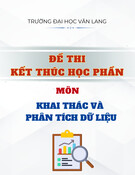
VNU Journal of Science: Comp. Science & Com. Eng., Vol. 40, No. 2 (2024) 1–11
Original Article
Developing an Objective Visual Quality Evaluation Pipeline
for 3D Woodblock Character
Le Cong Thuong1, Viet Nam Le1, Thi Duyen Ngo1, Seung-won Jung2, Thanh Ha Le1∗
1VNU University of Engineering and Technology, 144 Xuan Thuy, Cau Giay, Hanoi, Vietnam
2Department of Electrical Engineering, Korea University, Seoul, South Korea
Received 05 February 2024
Revised 12 June 2024; Accepted 10 December 2024
Abstract: Vietnamese feudal dynasty woodblocks are invaluable national treasures, but many have
been lost or damaged due to wars and poor conditions of preservative environments. Fortunately,
2D-printed papers of the damaged or lost woodblocks have been well-preserved, allowing for recon-
struction their 3D digital version. To ensure accurate reconstruction of 3D woodblocks, it is essential
to have a reliable alignment method that closely matches human visual perception. In this paper,
we introduce an automatic pipeline for objective visual quality evaluation of woodblock characters.
The pipeline includes two components: the first shifts the quality evaluation from 3D domain to 2D
domain by employing orthogonal projection to transform a 3D mesh woodblock character model into
a 2D depth map image with minimum information loss. The second utilizes established 2D percep-
tual metrics, which closely align with human visual perception, to evaluate the 2D depth map. Our
evaluation demonstrates that features of these proposed perceptual metrics employed in the pipeline
can effectively characterize the visual appearance of the woodblock character based on our prepared
dataset. Additionally, the experiments presented in the paper also demonstrate that these metrics
can sensitively detect degradation levels in both the foreground and background components of a
woodblock character.
Keywords: depthmap image, learned perceptual metrics, woodblock evaluation
1. Introduction
Woodblocks from feudal dynasties,
illustrated in Figure 1, are a national treasure,
∗Corresponding author.
E-mail address: ltha@vnu.edu.vn
https://doi.org/10.25073/2588-1086/vnucsce.2248
particularly in East Asia, including Korea, China,
Vietnam, and Japan. In Vietnam, the Nguyen
Dynasty’s printing woodblocks have gained
international recognition, as UNESCO included
1

2L. C. Thuong et al. /VNU Journal of Science: Comp. Science &Com. Eng., Vol. 40, No. 2 (2024) 1–11
them in the World Memory Program in 2009
[1]. However, many have been lost or damaged
due to war, weather, or poor physical conditional
preservation. Fortunately, the corresponding
2D-printed papers are well-preserved, providing
an opportunity for 3D digital reconstruction.
Quality assessment of 3D character woodblocks,
illustrated in Figure 2, is imperative, with
the primary challenge being the accurate
measurement of the reconstructed woodblock’s
quality in comparison to the ground truth.
Figure 1.Examples of physic 3D woodblock and
corresponding 2D prints.
Subjective assessments of woodblocks [1]
require human experts and cannot be automated.
In contrast, current objective metrics such as
Chamfer Distance (CD) [2] and Hausdorff
Distance (HD) [3] are widely used for 3D
reconstruction problems. These metrics measure
the similarity between two point sets by assigning
point pairs based on the nearest neighbor search.
Other metrics incorporate low-level attributes
such as differences in normal orientations [4]
or curvature information [5]. However, these
low features may not fully align with human
perception as shown in [4, 6].
Therefore, the paper proposes an objective
visual quality evaluation pipeline for measuring
the quality of 3D woodblock characters. The
pipeline includes 2 main components: the first
component maps a 3D woodblock character
to a depth map using orthogonal projection,
and the second component employs perceptual
2D metrics such as Deep Image Structure
and Texture Similarity (DISTS) [7] or Learned
Perceptual Image Patch Similarity (LPIPS) [8]
to assess the quality of the resulting depth
map. The approach utilizes available perceptual
metrics for images designed to align with human
perception, ensuring an objective evaluation of
the reconstructed woodblock’s visual appearance.
The pipeline presents that the set of features
from the DISTS or LPIPS metric used is
sufficient to capture the visual appearance of
woodblock character depth under our prepared
dataset. Additionally, our experiments show that
the pipeline is also sensitive to different types of
degradation in both foreground and background
regions.
Figure 2.The evaluation problem: How to measure
the quality of the generated character woodblock with
the ground-truth one?
2. Related work
This section provides an overview of
common objective and subjective metrics used
for evaluating 3D reconstructed objects. As our
pipeline involves evaluating 3D objects through
2D images, we also examine common metrics
used for 2D image evaluation.
Subjective 3D quality assessment.
Assessing the subjective quality of 3D models
relies on human observers participating in
experiments where they evaluate the perceived
quality of distorted or modified models.
Subjective quality assessment for 3D models
requires human observers to participate in
experiments where they evaluate the perceived

L. C. Thuong et al. /VNU Journal of Science: Comp. Science &Com. Eng., Vol. 40, No. 2 (2024) 1–11 3
quality of distorted objects. In the woodblock
domain, Ngo et al. [1] proposed assessment
criteria encompassing both objective and
subjective aspects, ensuring preservation
requirements for the entire woodblock. However,
this approach necessitates expert involvement
and lacks automation capabilities. Additionally,
Apollonio et al. [9] suggest a validation pipeline
that comprises six distinct categories: data
collection, data acquisition, data analysis, data
interpretation, and data representation. The
pipeline’s success depends on adhering to
different standards and assumptions at each
stage to minimize subjective results in the 3D
reconstruction output. Overall, subjective quality
assessment for woodblocks requires human
experts and cannot be automated.
Objective 3D quality assessment. Chamfer
Distance and HausdorffDistance are commonly
used as purely geometric error measures in
point cloud tasks. These metrics use the
nearest neighbor search to establish point pairs.
Other metrics incorporate low-level features like
normal orientation differences [4] or curvature
information [5], but they may not fully align with
human perception. As a result, these metrics
often yield poor results when used to evaluate
subjective datasets [4, 6].
Objective 2D quality assessment. Objective
2D quality assessment, or objective image quality
assessment (IQA) is a field that focuses on
developing computational models to predict the
perceived quality of visual images. Full-reference
IQA methods compare a distorted image to
a complete reference image. According to
[10], full-reference methods can be divided
into five categories: error visibility, structural
similarity, information-theoretic, learning-based,
and fusion-based methods. Error visibility
methods apply a distance measure directly to
pixels, such as mean squared error (MSE).
Structural similarity methods are constructed to
measure the similarity of local image structures,
often using correlation measures, and typical
metrics include the Structural Similarity Index
(SSIM) [11]. Information-theoretic methods
measure some approximations of the mutual
information between the perceived reference
and distorted images, typical visual information
fidelity (VIF) metrics [12]. Learning-based
methods learn a metric from a training set of
images and corresponding perceptual distances
using supervised machine learning methods.
Fusion-based methods combine existing IQA
methods. Recently, learning-based methods have
been rapidly developed, and deep neural network-
based metrics such as LPIPS [8] and DISTS [7]
have offered the best overall performance based
on learned perceptual features [10].
3. Methods
As demonstrated in Section 2, conventional
3D quality metrics fall short of woodblock
character evaluation. However, based on both
practical woodblock creation and observations
from [13], we have discovered a key property:
due to the process of constructing printing
woodblocks, the woodblock-making technique in
Asia begins with a smooth rectangular block.
This block is then carved to create the slope
of the characters. From the direction of the
carving, which is orthogonal to the surface of the
woodblock characters, all the information can be
observed. This allows us to represent them as 2D
depth maps with minimal detail loss. This opens
the door to leveraging established 2D perceptual
metrics for evaluation, which closely align with
human perception.
Figure 3 illustrates our automatic objective
visual pipeline, which consists of two key steps:
•3D-to-Depthmap mapping: The input
mesh woodblock characters C1and
C2undergo orthogonal projection and
quantization through module P, resulting in
the generation of orthographic depth map
images of woodblock characters D1and
D2, respectively. This process facilitates the

4L. C. Thuong et al. /VNU Journal of Science: Comp. Science &Com. Eng., Vol. 40, No. 2 (2024) 1–11
transition from the 3D to the 2D domain for
shift evaluation.
•Perceptual evaluation: The depth map
images of woodblock characters D1and D2,
are subject to evaluation using the learned
perceptual metric module M. This module
is specifically designed for 2D images
and generates a score S, which quantifies
the similarity between the two woodblock
characters.
Figure 3.The comprehensive automatic objective
visual evaluation pipeline and notation system for
woodblock analysis.
3.1. 3D-to-Depthmap Mapping
The mapping process is carried out in
a simulation environment, primarily using
the Open3D library, when depth maps are
generated using orthographic projection. In this
environment, depth maps are generated using
orthographic projection. The projection direction
is carefully aligned to be perpendicular to the
surface of the woodblock character. To ensure
consistency and accuracy, the distance from
the camera surface to the character surface is
maintained at a fixed 12 units. Figure 4 illustrates
the orthographic projection. The resulting depth
map assigns a distance value to each pixel,
representing the distance between the camera
plane and the surface in the orthogonal direction.
This distance value is then mapped and quantized
to the range of 0 to 255. The significance of this
2D depth map representation is that it enables
evaluation using 2D perceptual metrics, shifting
the focus from 3D to 2D analysis.
Figure 4.Illustration of orthographic projection of the
woodblock character, and notation system
3.2. Perceptual Evaluation
Deep perceptual metrics are becoming
increasingly dominant in the full reference metric
problem. These metrics are the features in a
neural network that is trained with millions
of data samples, allowing it to obtain better
statistics of the object compared to other metric
types such as error visibility metrics like MSE
and SSIM [11] or information measures such as
visual information fidelity (VIF) [12]. Step 2 of
our proposed pipeline focuses on two commonly
used deep perceptual metrics: DISTS [7] and
LPIPS [8], which offer more comprehensive
descriptions that closely align with human visual
perception.
•DISTS metric. The Deep Image Structure
and Texture Similarity (DISTS) metric
combines structural and textural information
to evaluate image quality. It transforms
the reference and distorted images using a
variant of the VGG network [14], which
is pre-trained for object recognition on the
ImageNet database. The transformation

L. C. Thuong et al. /VNU Journal of Science: Comp. Science &Com. Eng., Vol. 40, No. 2 (2024) 1–11 5
involves spatial convolution, half-wave
rectification, and downsampling, with
modifications to ensure the representation
is aliasing-free and injective. The resulting
representation captures both local structural
distortions (such as noise or blur) and
textural resampling. DISTS uses learnable
weights optimized to balance structural
and texture similarities provides a robust
assessment of image quality that correlates
well with human perception.
•LPIPS metric. The Learned Perceptual
Image Patch Similarity (LPIPS) metric uses
a pre-trained deep neural network, typically
VGG, to extract features from reference and
distorted images. It computes the perceptual
distance by calculating a weighted sum of
the distances between the feature maps of
image patches. The weights are learnable
and optimized to match human perceptual
judgments. LPIPS is trained on the
Berkeley-Adobe Perceptual Patch Similarity
(BAPPS) dataset, which includes a wide
variety of image distortions, allowing it to
generalize well across different types of
visual impairments. This method leverages
the deep features’ ability to capture complex
aspects of human perception, providing a
more accurate assessment of image quality
compared to traditional metrics.
In the paper, we use the DISTS and LPIPS
because of the following reasons:
•Compared to traditional metrics like PSNR
(Peak Signal-to-Noise Ratio) and SSIM
(Structural Similarity Index), these chosen
metrics leverage deep learning and capture
high-level features, and robustness across
diverse image types compared to other
metrics as shown [7, 10].
•Compared to other deep perceptual metrics,
despite these metrics not latest metrics, these
metrics have been extensively validated in
the literature and adopted by the computer
vision community for perceptual similarity
[7, 10, 15, 16].
4. Evaluation
In this section, we evaluate important aspects
of 3D problem reconstruction metrics such as
degradation sensitivity, the impact of woodblock
components, and capturing the visual appearance
of woodblock characters. We do not aim to
prove the effectiveness of DISTS or LPIPS
metrics, widely recognized as reliable metrics for
evaluating image quality, as they are designed
to align with human perception. Our goal is to
strengthen the pipeline and provide a more solid
analysis of the problem.
4.1. Datasets
For the evaluations in subsequent sections, a
dataset, denoted as HMI-TRIPLE-WB, utilizing
a subset of the 3D digital woodblock collection
from the Human-Interaction Laboratory at the
University of Engineering and Technology. This
original collection comprises high-resolution
mesh models of entire woodblocks, each with
a resolution ranging from 40 million to 100
million vertices, captured using the ATOS Q
12M machine. From this extensive collection,
individual characters were carefully selected
and cropped to compose the HMI-TRIPLE-WB
dataset. Specifically, this dataset includes a total
of 24 samples, each derived from five historical
woodblocks, which are part of the Dai Nam Thuc
Luc historical records. Each sample within the
dataset contains three woodblock characters and
fulfills the following two requirements:
•Characters in each sample share the same
textual symbol.
•All characters within each sample originate
from the same whole woodblock.



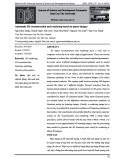
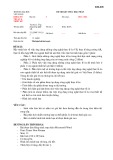
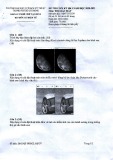
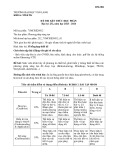
![Tài liệu giảng dạy Phát triển ý tưởng Trường CĐ Công nghệ TP.HCM [Mới nhất]](https://cdn.tailieu.vn/images/document/thumbnail/2024/20240830/xuanphongdacy04/135x160/1892634747.jpg)



